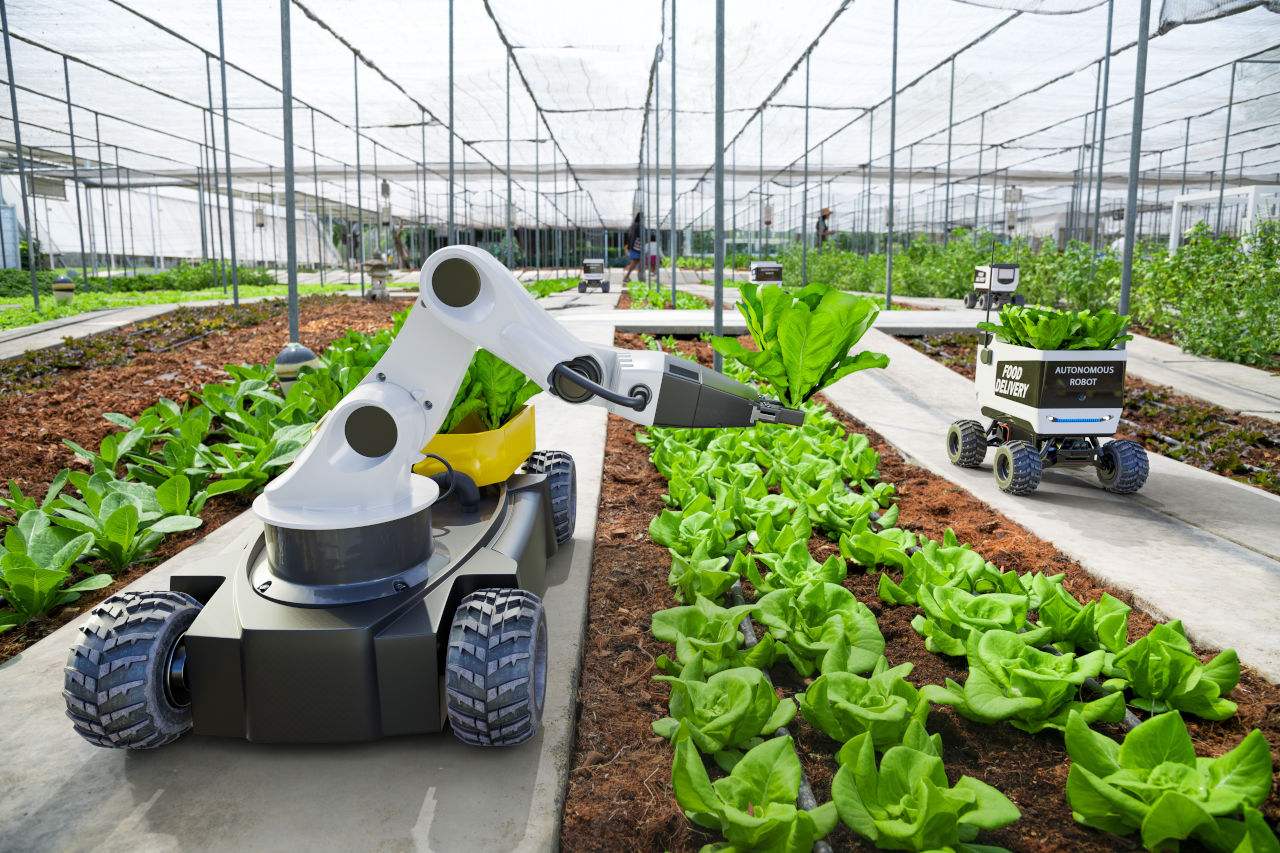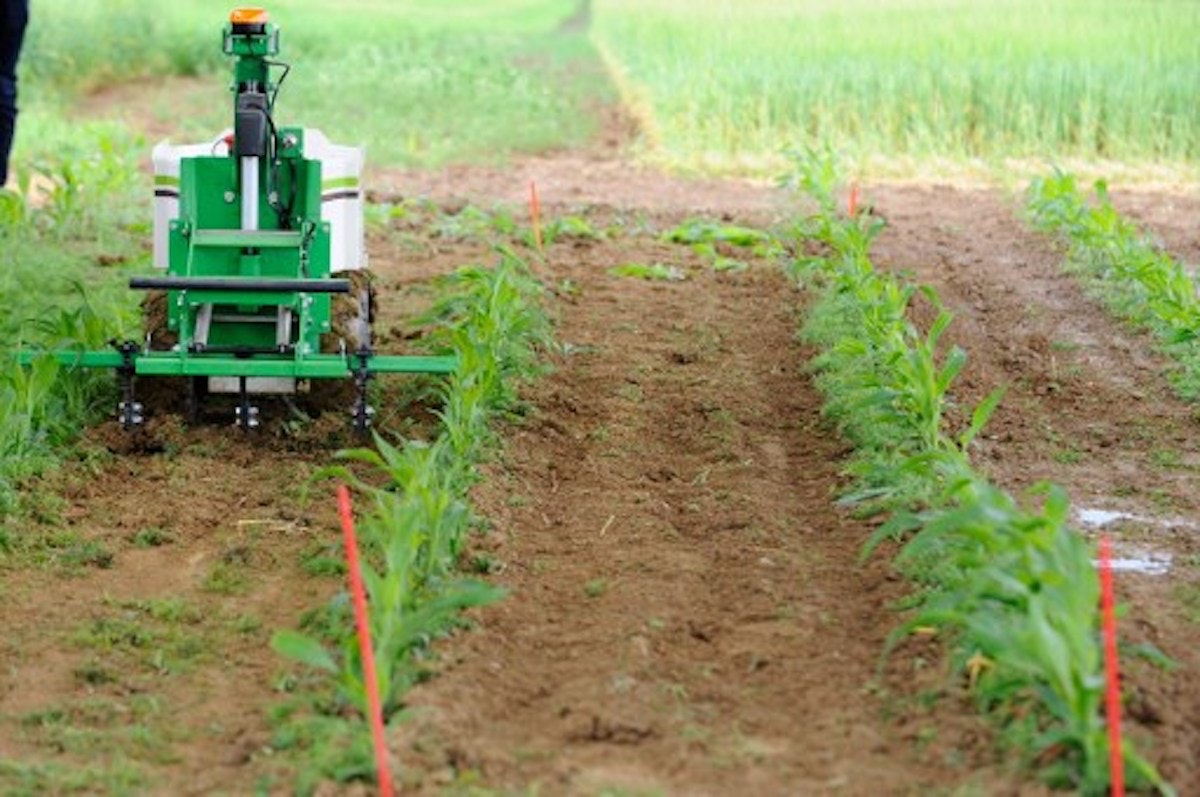Can agriculture 4.0 be responsible?
From imposing connected tractors to almost invisible electronic sensors, digital technology is increasingly making its presence felt on farms, in a variety of forms.
Ysé Commandré, IAE MontpellierGeorge Aboueldahab, University of Montpellier and Romane Guillot, University of Montpellier

Kinwun stock.adobe.com
It offers a range of services to improve resource use efficiency and strengthen farm resilience (animal and soil health, biodiversity protection, information gathering). Its use can also contribute to knowledge creation and collective governance of these resources.
Some farmers, however, take a dim view of this growing incursion of digital technology into their fields. On February 9, 2022, after the publication of the agricultural section of the government's stimulus plan, the Drôme Departmental Directorate of Territories was occupied by farmer collectives contesting the 3 axes set out in the plan by the former Minister of Agriculture, Julien Denormandie, for the future of agriculture: digital, robotics and genetics.
[More than 80,000 readers trust The Conversation newsletter to better understand the world's major issues. Subscribe today]
Because, while it is often presented as a solution to environmental challenges - for example, to reduce the use of inputs - "agriculture 4.0" could also make the sector just as polluting, if not more so, than before.
In addition to the "classic" pollutants generated by industrial agriculture, there is also the contamination caused by digital technology. In other words, while digital technology can help reduce certain types of agricultural pollution, such as input pollution, the tools used to do so are not without impact.
The most skeptical also see the risk of a loss of autonomy for farmers and the disappearance of non-productivist forms of agriculture. In a report published in 2021, the consulting firm Basic concluded that the dominant logic behind the digitization of agriculture remains the maximization of yields and the industrialization of the sector.
A THIRD AGRICULTURAL REVOLUTION?
After a first revolution driven by mechanization(in the 1950s), then a second based on the use of chemical inputs (from the 1960s), digital technology seems to embody the third agricultural revolution, widely supported by public authorities.
The OECD, for example, encourages governments to acquire satellite imagery to "reduce the cost of monitoring many agricultural activities. Policy-makers could then opt for more targeted measures under which farmers would receive payments (or be penalized) based on observable environmental results".
In France, the public sector invested 1.1 billion euros in agricultural research in 2015, with spending up 1.2% in volume terms year-on-year. No figures break down distinctions between R&D linked to digital agriculture and the rest of R&D, but the State is active in building an ecosystem in favor of "digital agriculture". This is evidenced by the Digital Farm, which submitted an inventory of the ecosystem and its needs to the Ministry of Agriculture in February 2022.
The DigitAg Convergence Institute, which aims to bring together scientific research projects on digital agriculture, has been allocated a budget of 9.9 million euros over eight years. Public Sénat's YouTube channel also relays videos promoting digital agriculture.
While public subsidies for agricultural associations are made conditional on a commitment to "keep the peace" - subsidies are not renewed in the event of actions on their part that are deemed to undermine public order - AgTech start-ups make money from fund-raising, only to be bought out by major groups or go bankrupt even though public money had been invested in them. Many of those working in the fields of robotics and artificial intelligence have been taken over by the American farm machinery giant John Deere, emblematic of the challenges posed by the industrialization and digitization of agriculture.
LOSS OF AUTONOMY
Following farmers' opposition to the Digital Millennium Copyright Act, this manufacturer has become the subject of a legislative battle in the United States. This law gives the company exclusive rights to repair and modify the software it integrates into the tractors it sells, forcing its customers to go through authorized repairers... or to pirate the software. In the USA, the right to repair is now subject to the legislation in force in each state.
This type of barrier restricts the resilience and autonomy of farmers, who no longer have the official right to adapt or repair these machines, even if they have the skills to do so. The John Deere case is the most decried in this respect, and with good reason: in France, one tractor in 5 is a John Deere. Some associations, such as Atelier Paysan, are trying to counter this phenomenon, which makes self-repair of agricultural equipment impossible.
Although spare parts and repair services are 3 to 6 times more profitable than original equipment sales, John Deere claims that its approach is primarily aimed at ensuring the safety of farm machinery users. In other words, attempting to carry out a repair on your own would be dangerous for those who subsequently drive the machines.
STANDARDIZATION AND APPROPRIATION OF LIVING THINGS
If the use of digital technology meets with resistance, it's also because it's often associated with genetic innovations, particularly in the context of genetic selection practices (plant and/or animal), the methods of which are far from universally accepted.
To be registered in the official catalog, and therefore legally used and sold for commercial and productive purposes, a variety must meet the criteria of "Distinctness, Homogeneity, Stability", which severely limits genetic diversity and selection by farmers. Several farming communities - in France, the Réseau semences paysannes, and in Latin America, the Via Campesina - remain attached to ancestral practices that they consider more virtuous and respectful of biodiversity.
Some also believe that the use of digital technology for genetic advances is responsible for the industrial appropriation of common natural resources.

Jean-Christophe Verhaegen/AFP
The proliferation of sensors and connected objects also calls into question the ability of agriculture 4.0 to evolve in diversified cropping systems. The use of farmer seeds, old varieties and varietal mixes is nevertheless recommended by certain associations to better adapt to climate change and local conditions. However, the considerable heterogeneity of these varieties (in terms of size, shape, input requirements, etc.) makes them difficult to grow on an industrial scale.
On the contrary, genetic advances are moving in the direction of standardizing living organisms to facilitate the use of new tools, as was the case with agricultural mechanization, by adapting living organisms to tools rather than tools to living organisms.
DATA AT STAKE
Another controversial aspect of digitization is the data collection it generates: thanks to on-board sensors and computers, software records and transmits a multitude of data such as soil moisture, nitrogen and other nutrient levels, seed, fertilizer and pesticide placement, as well as harvest quality and quantity.
Several researchers point to the risk of reselling this data to develop new solutions for... farmers themselves. As early as 2011, John Deere collected and transmitted to other companies in the sector the production data of farmers using its connected tractors, without warning them.
But some farmers are also willing to divulge their information to these companies so that they can improve the solutions they sell. The world's4th largest tractor manufacturer, AGCO Corp. which manufactures Challenger and Massey Ferguson machines, initially refused to divulge its customers' production data to a third party. However, as some farmers are demanding more data-related services, this policy has been modified.
On a societal scale, the alliance between agrochemical and digital giants points to the danger of our food supply becoming increasingly dependent on multinationals. The capture and use of agricultural data makes farming more vulnerable: cyber-attacks and crop predictions by territory are threats to food security. Major weaknesses have been identified in John Deere's software and New Holland's CNH Industrial systems.
DIGITAL AGRICULTURE, A RESPONSIBLE FACE?
An agriculture 4.0 in the hands of multinationals poses great risks for the agricultural sector and farmers, but not everything in digital tools is disposable.
Some may have real potential to support the development of resilient, self-sufficient agriculture. Through their immediacy and ease of access, they can increase knowledge sharing and contribute to the conservation of farming knowledge. Through social networks, farmers can exchange advice, feedback and knowledge of farming practices...
Making data available through open, transparent and consensual processes can lead to the construction of collaborative networks and improve farmers' access to technologies. However, these initiatives are limited by farmers' legitimate fears of being dispossessed of their data and knowledge.
The creation of knowledge and digital tools by, with and for farmers appears essential. Some initiatives, such as the InPACT cluster, an associative platform resulting from the merger of agricultural association networks, propose the construction of technological sovereignty for farmers through the active integration of farmers in the innovation and creation processes. The aim is to build tools that are both better adapted to farmers' needs and more intensive in terms of know-how and knowledge, without depriving them of their expertise.
Ysé Commandré, Doctoral student in management sciences, IAE MontpellierGeorge Aboueldahab, Doctoral student, University of Montpellier and Romane Guillot, Ph, University of Montpellier
This article is republished from The Conversation under a Creative Commons license. Read theoriginal article.